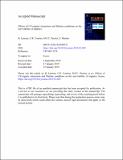Files in this item
Effects of UV-organic interaction and Martian conditions on the survivability of organics
Item metadata
| dc.contributor.author | Laurent, B. | |
| dc.contributor.author | Cousins, C. R. | |
| dc.contributor.author | Pereira, M. F. C. | |
| dc.contributor.author | Martins, Z. | |
| dc.date.accessioned | 2020-01-24T00:35:16Z | |
| dc.date.available | 2020-01-24T00:35:16Z | |
| dc.date.issued | 2019-01-24 | |
| dc.identifier | 257572765 | |
| dc.identifier | 44a16171-2afb-43a7-9552-e005b390ef47 | |
| dc.identifier | 85060884252 | |
| dc.identifier | 000461846100003 | |
| dc.identifier.citation | Laurent , B , Cousins , C R , Pereira , M F C & Martins , Z 2019 , ' Effects of UV-organic interaction and Martian conditions on the survivability of organics ' , Icarus , vol. In press . https://doi.org/10.1016/j.icarus.2019.01.020 | en |
| dc.identifier.issn | 0019-1035 | |
| dc.identifier.other | RIS: urn:023D7D04C56ADA53E103F202FD542D95 | |
| dc.identifier.other | ORCID: /0000-0002-3954-8079/work/60196596 | |
| dc.identifier.uri | https://hdl.handle.net/10023/19346 | |
| dc.description | This work was funded by the Leverhulme Trust (RPG-2015-071). Dr. C. Cousins also wishes to acknowledge funding from the Royal Society of Edinburgh. This work was financed by FEDER - Fundo Europeu de Desenvolvimento Regional funds through the COMPETE 2020 - Operacional Programme for Competitiveness and Internationalisation (POCI), and by Portuguese funds through FCT - Fundação para a Ciência e a Tecnologia in the framework of the project POCI-01-0145-FEDER-029932 (PTDC/FIS-AST/29932/2017). | en |
| dc.description.abstract | Exogenous organic molecules are delivered to the surface of Mars annually, yet their fate is largely unknown. Likewise, the survivability of putative organic biomarkers directly implicates current Mars surface exploration ambitions. Among these, amino acids are valuable target molecules due to their abiogenic and biological origins. We present the fundamental, but not previously considered, factors that affect the fate of amino acids embedded in Mars mineral analogues when exposed to ionising radiation. Using existing experimental datasets, we show that the attenuation coefficient at 200 nm for amino acids is an effective parameter for quantifying organic survivability, especially when mineral shielding is limited or absent. Conversely, the dielectric constant of a material is a potential key parameter regarding mineral shielding, as it accounts for iron content, and the physical properties of the material (pore size, surface area or water content). Finally, we combine Martian climatic parameters (surface temperature and atmospheric opacity) to show that the relative UV environment varies significantly on Mars as a function of latitude, providing a reference point for future Mars simulation studies. | |
| dc.format.extent | 1532564 | |
| dc.language.iso | eng | |
| dc.relation.ispartof | Icarus | en |
| dc.subject | Irradiation | en |
| dc.subject | Mars | en |
| dc.subject | Analogue | en |
| dc.subject | Attenuation coefficient | en |
| dc.subject | Amino acids | en |
| dc.subject | GE Environmental Sciences | en |
| dc.subject | NDAS | en |
| dc.subject.lcc | GE | en |
| dc.title | Effects of UV-organic interaction and Martian conditions on the survivability of organics | en |
| dc.type | Journal article | en |
| dc.contributor.sponsor | The Leverhulme Trust | en |
| dc.contributor.sponsor | The Royal Society of Edinburgh | en |
| dc.contributor.institution | University of St Andrews. St Andrews Centre for Exoplanet Science | en |
| dc.contributor.institution | University of St Andrews. School of Earth & Environmental Sciences | en |
| dc.identifier.doi | 10.1016/j.icarus.2019.01.020 | |
| dc.description.status | Peer reviewed | en |
| dc.date.embargoedUntil | 2020-01-24 | |
| dc.identifier.grantnumber | RPG-2015-071 | en |
| dc.identifier.grantnumber | en |
This item appears in the following Collection(s)
Items in the St Andrews Research Repository are protected by copyright, with all rights reserved, unless otherwise indicated.

